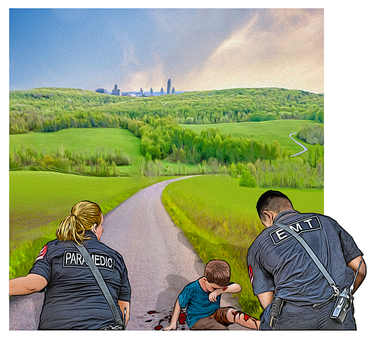A matter of life and death: Equity for rural EMS
A century ago, as readers of our weekly Back In Time column know, mishaps and sudden medical problems, like suffering a stroke, often became fatalities.
Last week 100 years ago, for example, we reported that a boy in Esperance in rural Schoharie County, “fell from a place in the barn several feet in height. He struck his face on a concrete floor and is thought to be injured internally.”
There were no ambulances to rush an injured person to the hospital, providing an essential medical lifeline on the way. We often reported on how people languished at home, sometimes attended by a local doctor, until they died.
Now, of course, we expect and count on trained medical staff to rush to the rescue. But the service is not available equally in the towns we cover. This inequity is not peculiar to Albany County.
The inequity is nationwide. Roughly one in five United States residents live in a rural area.
On average, rural Americans are older, sicker, and poorer than their suburban or urban counterparts. A study published by the Centers for Disease Control and Prevention in 2017 found, “Compared with metropolitan areas, nonmetropolitan areas have higher age-adjusted death rates and greater percentages of potentially excess deaths from the five leading causes of death, nationally and across public health regions.”
The study teases out many reasons for this. Among them are that rural residents tend to have less access to health care and preventative measures and are more likely to live in poverty, to smoke, and to suffer from hypertension and obesity.
The five leading causes of death during the time of the CDC study, from 1999 to 2014, were heart disease, cancer, unintentional injury, chronic lower respiratory disease, and stroke. For all of those causes, rural residents had a higher percentage of potentially excess deaths.
The gap is widening between rural and urban Americans not just in poverty rates but in life expectancy.
A study published by American Journal of Preventive Medicine in 2014 shows that, based on data from 1969 to 2009, the average life expectancy of rural Americans was 76.7 years, which is almost 2.5 years less than for metropolitan Americans.
Another study, based on data from 1980 to 2014, looked at life expectancy on a county-by-county basis across the nation where, in some places, the difference in life expectancy between rural and urban areas was more than 20 years.
The map of New York state shows downstate — the New York metropolitan area and the part of Long Island closest to the city — colored blue, meaning a life expectancy of 84 to 87 years. Most of the state is colored green, indicating a life expectancy of 78 to 81 years, while some rural areas are colored yellow, signifying a life expectancy of 75 to 78 years.
Counties in South Dakota and North Dakota had the lowest life expectancy; they are colored dark red, signifying a life expectancy of 66 to 69 years. Counties along the lower half of the Mississippi, in eastern Kentucky, and southwestern West Virginia also had very low life expectancy compared with the rest of the country.
“In the face of this glaring healthcare disparity, rural Emergency Medical Services (EMS) often become the only guaranteed access to health services, and ultimately, the safety net for underserved rural communities,” writes the National Rural Health Association in a policy brief. “However, dwindling population, losses in the volunteer workforce, and decreased reimbursement threaten continued access to these services. Nearly one-third of rural Emergency Medical Services (EMS) are in immediate operational jeopardy.”
This is the situation our rural communities in Albany County find themselves in. While we have written about the Helderberg Ambulance squad in Berne heroically carrying on with volunteers supplemented by paid Emergency Medical Technicians and even student recruits, most of the volunteer squads have fallen by the wayside.
The Westerlo squad members announced through tears in 2019 that the squad would end its service due largely to the lack of volunteers.
That same year, Brian Wood, captain of Albany County’s EMS, explained why the county was moving to using full-time staff and fielded questions and complaints from municipal leaders about bearing the extra costs.
“Currently, the sheriff provides services and charges go back to the towns,” said Wood. “We pay for everything.”
The Westerlo supervisor at the time said he was “flabbergasted” by the “EMS costs without our own ambulance”; he anticipated a hike of 20 to 25 percent in costs for the town.
Wood explained then that workers would naturally leave a part-time county slot that pays less per hour for a full-time job with a town that pays more per hour and also offers benefits like health insurance, he said.
Paramedics in Guilderland, Wood said in 2019, earned about $28 per hour while paramedics working for the county earned $22 per hour. Guilderland emergency medical technicians earned $20 an hour while county EMTs earned $14.50, he said, adding he’s seen signs at local convenience stores indicating they pay workers more.
Training for an EMT typically takes four to five months, Wood said, while paramedics complete a two-year college course.
Since the state adopted a levy limit for municipalities, it has been difficult for the towns to keep up with the EMS costs, Wood said. “We’re hindered every year by the tax cap.”
Several town leaders four years ago called for Albany County to bear the costs, which the rural towns could ill afford. Wood pointed out that, since only some of the municipalities in Albany County are served by county EMS, it would be unfair to tax everyone.
The State Legislature, he said, would need to create a district within the county so that only those who are getting the service would be taxed. That process could take several years, he said in 2019, adding, “If that takes three years, it doesn’t help us in 2020.”
So here we are in 2023 — and the problem has become even more pressing.
To get and keep workers, our Hilltown reporter Noah Zweifel reported in a July 13 front-page story, the Albany County Sheriff’s Office is now increasing the wages of its emergency medical staff, which is widely supported by local leaders of communities that rely on these staff members for health care.
However, they worry that the cost increases will force them to break their state-set tax caps and may be unsustainable for their comparatively small budgets.
In the town of Westerlo, for example, Supervisor Matt Kryzak told The Enterprise that, in 2024, the cost for county EMS will jump 30 percent, from roughly $231,000 to just over $300,000.
For a town with a $3.3 million budget, he said, that’s “a lot to absorb.”
As such, Westerlo and the seven other municipalities that rely on the county EMS — Rensselaerville, Berne, New Scotland, Voorheesville, Bethlehem, Coeymans, and Ravena — are asking that the county create a special district through which it would tax residents directly for emergency medical services, rather than bill the towns, which then issue their own local taxes.
We wholeheartedly endorse this initiative. Assembly John McDonald, of the 108th District, has backed legislation to do just that. We agree with his assessment that setting up a special district would make for better delivery and coordination of emergency medical services.
It doesn’t make much difference for residents themselves, McDonald noted, since all that’s happening is the cost would be transferred from their local tax bill to a county tax bill. But, he said, the cost would be more transparent, rather than exist as a line or two buried in a local municipality’s budget that covers the costs of office supplies and employee benefits and everything in between.
He also notes that private EMS typically costs far more than public EMS, citing Cohoes as an example.
So where’s the rub? It is the state-set levy limit.
“Not many legislative bodies want to take a public vote to raise the tax cap …,” McDonald said, even if it’s for a cost that could be widely supported, like EMS staff. “At the end of the day, the average resident doesn’t know why you need to raise the tax cap; they just know that you voted to raise the tax cap.”
The special district would make it harder for the county budget to stay under the tax cap, even though it has no bearing on the actual cost for taxpayers.
“This is why the legislation hasn’t advanced — hasn’t even been drafted into its final form,” said McDonald.
Four years ago, when we called the Albany County Executive’s Office to ask if Executive Daniel McCoy would back a special district for ambulance services, spokeswoman Mary Rozak said that was the first she’d heard of it.
“We do anything and everything we can — the county executive is clear on that — to work with and help out every municipality in Albany County,” she said. “We don’t have any further information. If someone were to reach out to us, we could look into seeing if anything could be done.”
This month, when Zweifel asked about the special district again, Rozak said the county is “looking to do whatever we can to help local municipalities so they can keep their taxes under the cap.”
So here is what the county can and should do: Let state legislators know it is willing to back a special district for EMS. That should allow McDonald’s legislation to move forward. The county is far more able, with its $757 million annual budget, to absorb the cost while staying under the levy limit than small municipalities with budgets less than $5 million.
Rural areas just by their location, being more distant from hospitals, are already at a disadvantage when it comes to critical lifesaving minutes. Rural residents are 14 percent more likely to die after traumatic injury compared with nonrural residents, one study found.
National Emergency Medical Services Information System data shows that, on average, EMS total call time (from time unit is dispatched, the patient arrives at the hospital, and the EMS unit is ready for the next call) in rural areas of the United States are nearly 20 or 30 percent higher than suburban and urban areas.
“Fatality rates from rural vehicular trauma are almost double those found in urban settings,” one study says, finding that EMS call time in the case of fatal car accidents was over 40 percent higher in rural than in urban areas.
With opioid overdoses, a patient typically has depressed respiratory function so, one study found, the 9.4 extra minutes, on average, that it takes to transport a rural overdosed patient to a local hospital is often the difference between life and death.
We should have progressed from the point where we were a century ago when a boy who falls in a rural town and may be bleeding internally is treated differently than one who falls in a city and can more easily be taken to a hospital.
We must strive for equity. With support from Albany County, state legislators can move forward in creating a district that will both ensure fair pay for ambulance workers while also ensuring rural towns don’t go broke.
It is, indeed, a matter of life and death.


